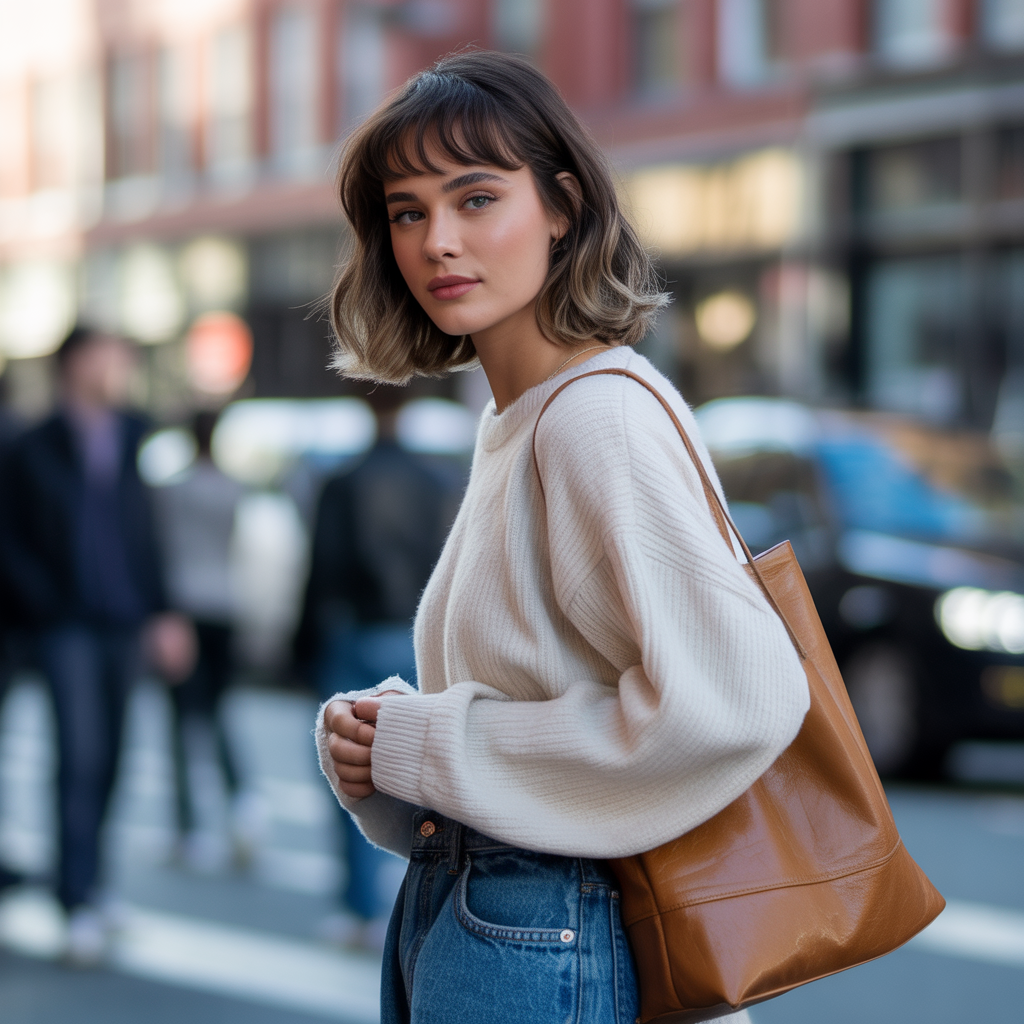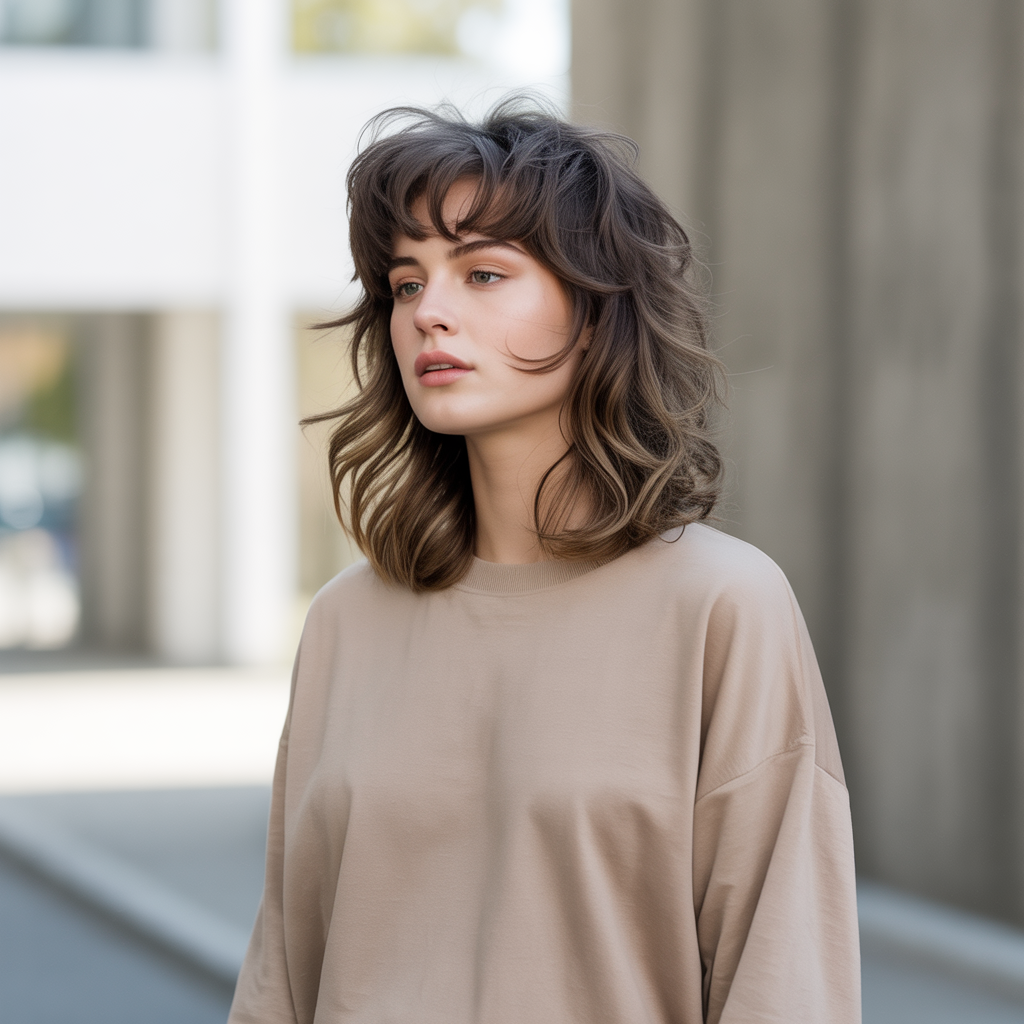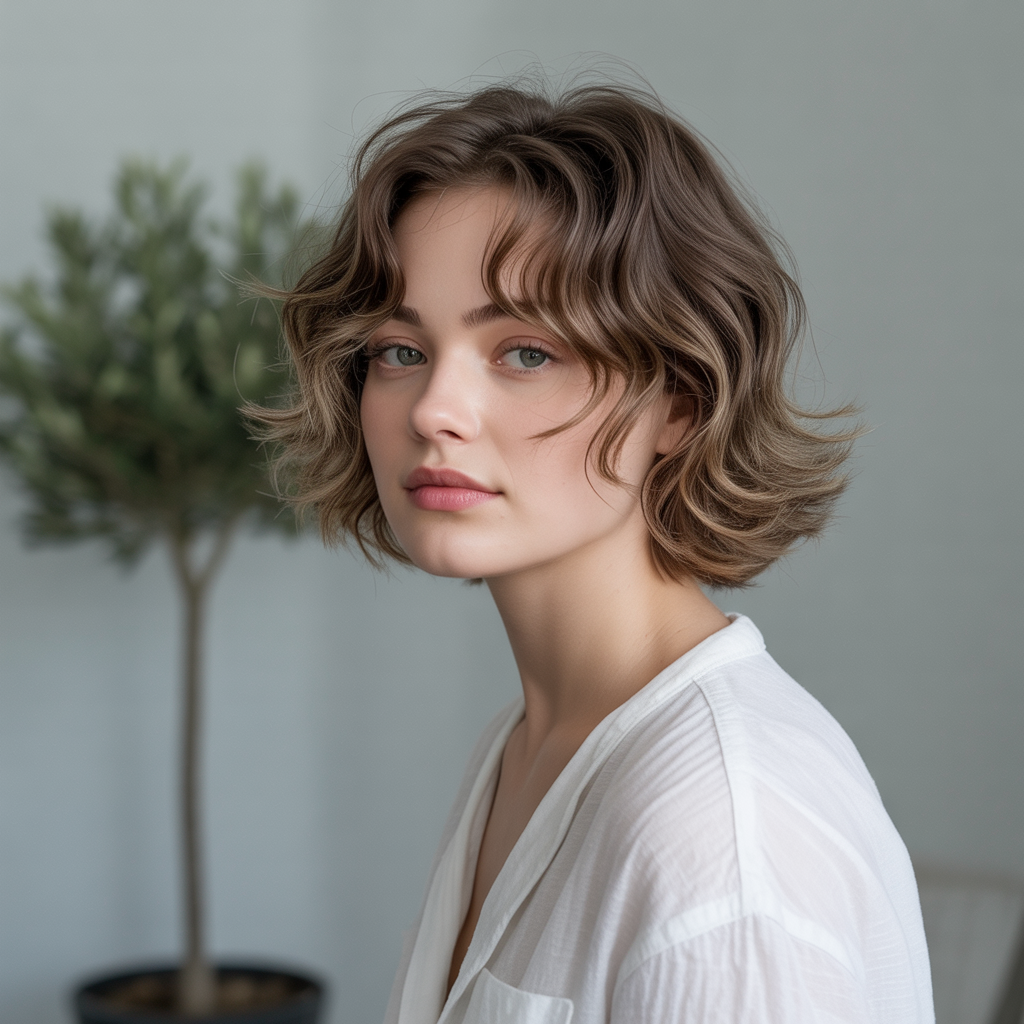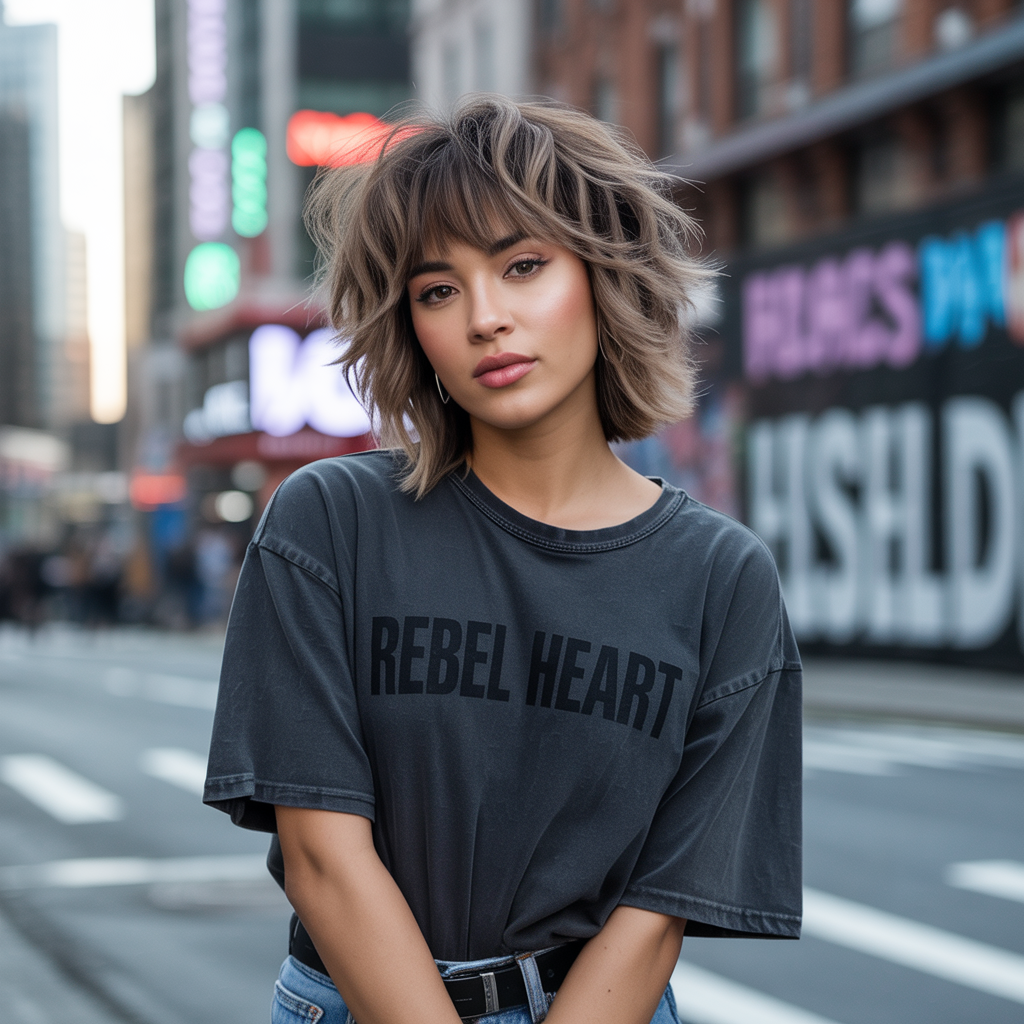10 Trendy Medium Shag Haircuts for Effortless Style
If you’re craving movement, texture, and a little edge without sacrificing everyday wearability, medium shag haircuts are the sweet spot. Hitting around shoulder-length, the modern shag keeps the crown light, the ends wispy, and the face framed with soft pieces that style themselves. Below are ten fresh, salon-realistic ideas—each with who it suits, how to ask your stylist, and tips to make styling fast.
Classic ’70s-Inspired Shag

The O.G. shag is all about a feathered crown, cheekbone-hugging layers, and ends that flick out for effortless volume. It keeps the silhouette round at the top and slimmer through the lengths, so hair looks fuller without feeling bulky.
Best for: Straight to wavy textures; medium density; anyone who wants extra crown lift.
Why it works: The short-to-long layering removes weight at the crown and encourages natural movement, so even “flat” hair pops with shape.
How to ask your stylist:
- “Shoulder-length base with shaggy, graduated layers starting at the temples.”
- “Soft, wispy perimeter—no blunt lines.”
- “Internal texturizing around the crown for airy lift.”
Styling tips: Rough-dry upside down, scrunching a lightweight mousse. Flip upright and touch the ends with a medium round brush to encourage that retro flick.
Maintenance: Micro-dust every 8–10 weeks to keep the shape fluffy, not frayed.
Curtain Bangs Shag

A medium shag paired with curtain bangs gives instant face framing and zero-regret grow-out. The bangs part down the middle (or off-center) and melt into cheekbone layers.
Best for: Round, oval, or heart face shapes; anyone who wants softening around the features.
Why it works: The long fringe skims brows and cheekbones, narrowing wide foreheads and adding femininity to the shag’s rock-and-roll texture.
How to ask your stylist:
- “Collarbone length with seamless layers and curtain bangs that hit between brows and cheekbones.”
- “Minimal thinning—keep the ends soft, not stringy.”
Styling tips: After drying, tap a large curling iron horizontally just through the fringe for a curtain swoop. Mist with light flexible spray.
Maintenance: Bangs benefit from a quick trim every 4–6 weeks; the rest can stretch to 10.
Wolf Cut (Medium Length)

The wolf cut blends mullet-ish attitude with shag layering, but at a wearable medium length. Think fuller crown, elongated layers through the sides, and a wispy neckline—not a harsh mullet.
Best for: Straight, wavy, and loose curls; medium to thick density; those who love shape at the top.
Why it works: Heavier layering up top redistributes bulk, making thick hair feel lighter without sacrificing drama.
How to ask your stylist:
- “Shoulder to collarbone base with heavy crown layers that diffuse into longer, piecey sides.”
- “Face-framing starting at the pupils and flowing into the perimeter.”
Styling tips: Use a texture spray on dry hair and pinch the ends to exaggerate separation.
Maintenance: Plan a reshape every 8–10 weeks to keep the crown intentional, not puffy.
Shaggy Lob

A lob (long bob) gets shaggified with airy layers and a soft, broken perimeter. You’ll keep some weight for polish, but the layers prevent the dreaded triangular shape.
Best for: Fine to medium hair; anyone who wants movement without losing too much length.
Why it works: Strategic internal layers chevron through the mid-lengths to create swing, so hair doesn’t sit flat on the shoulders.
How to ask your stylist:
- “Lob at the collarbones with light internal layering—no shelf-y steps.”
- “Leave subtle disconnection for piecey ends.”
Styling tips: Blow-dry with a paddle brush for speed, then bend random sections with a 1.25″ iron for undone texture.
Maintenance: 8–12 weeks; ask for dusting instead of taking off length.
Curly Medium Shag Haircuts

Curls + shag is a match made in volume heaven. Layering removes interior bulk so curls spring up instead of out, and face-framing pieces highlight eyes and cheekbones.
Best for: Curly patterns from 2C to 3C.
Why it works: Layering begins where your curl pattern naturally bends, so curls stack without frizz.
How to ask your stylist:
- “Dry cut on natural curl pattern.”
- “Vertical layers that respect curl clumps; minimal thinning.”
- “Face-framing starting at the cheekbones.”
Styling tips: Apply curl cream to soaking hair, plop for 15–20 minutes, then diffuse on low heat. Finish with a few drops of lightweight oil to separate.
Maintenance: Trim curls every 10–12 weeks to keep ends lively.
Wavy Shag with Face-Framing Layers

If your hair naturally has a bend, this shag amplifies it with slow, cascading layers that hug the face and open the neckline.
Best for: Naturally wavy hair that tends to look flat at the roots.
Why it works: Elevates crown layers for lift while encouraging wave pattern to activate mid-shaft and below.
How to ask your stylist:
- “Shoulder-grazing base, long face frame starting at the lips, crown de-bulked for lift.”
Styling tips: Use a root-lifting foam at the scalp and a light gel through the ends. Scrunch while diffusing.
Maintenance: 8–10 weeks to keep the face frame fresh.
Airy Razor Shag

Cut with a razor, this shag delivers ultra-feathery ends and maximum movement. It’s the closest thing to “I woke up like this” texture.
Best for: Medium to thick hair; straight to wavy textures; anyone who loves softness over bluntness.
Why it works: The razor bevels ends so they collapse into a naturally tousled shape without hot tools.
How to ask your stylist:
- “Razor cut with surface and internal slides; avoid over-thinning near the hairline.”
- “Maintain a softly rounded crown, not choppy.”
Styling tips: Air-dry with a sea-salt spray, then massage the crown to re-fluff.
Maintenance: Because razor ends can fray, schedule tidy-ups every 6–8 weeks.
Shag with Micro Bangs

Micro bangs (short, choppy fringe) instantly modernize a medium shag and make eyes the star. The contrast between short fringe and soft layers feels editorial but wearable.
Best for: Straight to wavy hair; oval or longer faces that benefit from a shorter forehead line.
Why it works: Short fringe balances longer face shapes and adds personality without heavy commitment.
How to ask your stylist:
- “Micro fringe skimming 1–2 cm above brows, textured not blunt.”
- “Shag layers that melt into the fringe corners.”
Styling tips: Blow-dry the bangs straight down with a flat brush, then pinch the ends with balm. Keep the rest tousled.
Maintenance: Bang trims every 3–4 weeks keep them sitting right.
Layered Shag for Thick Hair

When thickness becomes bulky, a layered shag removes internal weight while preserving width where you want it—usually around cheekbones and the lower face.
Best for: Thick, heavy hair that poofs at the bottom or collapses at the crown.
Why it works: Interior removal plus extended face-framing redistributes mass and gives lift.
How to ask your stylist:
- “Internal slide cutting through the mid-shaft; long crown layers for ventilation.”
- “No chunking—keep distribution even so ends don’t string out.”
Styling tips: Use a lightweight smoothing cream before blow-drying, then mist a texturizer after to keep movement.
Maintenance: 8–10 weeks for shape; deep condition monthly to keep ends supple.
Low-Maintenance Fine Hair Shag

Fine hair needs volume without aggressive thinning. This softer shag multiplies fullness at the crown and builds a diffused, piecey perimeter.
Best for: Fine hair that struggles to hold a curl; anyone wanting 5-minute styling.
Why it works: Shorter crown layers act like scaffolding to lift roots, while light texturizing creates believable thickness.
How to ask your stylist:
- “Minimal texturizing at the ends; strategic crown layers for lift.”
- “Preserve perimeter density—no razor fray.”
Styling tips: Mousse at roots, blow-dry upside down, and finish with a dry volume spray. Skip heavy oils that deflate.
Maintenance: 6–8 weeks keeps the scaffolding intact.
How to Choose Your Best Medium Shag (Quick Guide)
- Face shape:
- Round: Curtain bangs shag or micro bangs shag elongate and frame.
- Square: Airy razor shag softens angles with beveled ends.
- Heart: Shaggy lob or wavy shag balances a narrower chin.
- Hair texture:
- Straight: Classic ’70s shag, curtain bangs shag, or micro bangs shag.
- Wavy: Wavy face-framing shag or shaggy lob.
- Curly: Curly medium shag with a dry-cut approach.
- Lifestyle:
- Low-maintenance? Choose the fine-hair shag or shaggy lob.
- Love styling? Wolf cut or micro bangs shag offers more edge and versatility.
Sprinkle the exact phrase medium shag haircuts on your services page or in a post like this to help searchers find these looks without keyword stuffing.
At-Home Styling Playbook
- Prep matters: Shampoo less, condition more. A light leave-in detangler prevents tugging on layered ends.
- Build lift first: Apply a root foam at the crown; blow-dry with your head flipped forward for 70% of the dry time.
- Add bend, not curls: Use a 1–1.25″ iron to bend mid-lengths—leave the ends out for that shaggy finish.
- Texture on dry hair: Salt sprays and dry texture mists work best when hair is fully dry; scrunch and go.
- Finish wisely: Swap heavy serums for a drop of light oil rubbed between palms, then tapped only on the tips.
Salon Conversation Cheat Sheet
Copy this into your phone before your appointment:
- “I want a medium shag haircut around the shoulders with airy layers through the crown.”
- “Please keep the perimeter soft, not blunt, and blend the face-frame from cheekbones down.”
- “Minimal thinning—avoid over-texturizing so it doesn’t look stringy.”
- “Cut to enhance natural texture; I style in under 10 minutes.”
Color Pairings That Make Shags Pop
- Subtle balayage: A shade or two lighter on the ends amps up separation in layered cuts.
- Face-frame lights: Micro ribbons around the fringe and temples brighten the complexion and showcase the shag’s shape.
- Gloss, not bleach (for shine): A clear or tinted gloss seals the cuticle so feathery layers reflect light rather than frizz.
Common Mistakes to Avoid
- Over-thinning the ends: Creates a stringy, scraggly finish—ask for controlled internal removal instead.
- Layer shelves: Visible steps in layers interrupt movement; request seamless, vertical layer transitions.
- Ignoring your natural part: Your shag should be cut to your real, comfortable part for easy daily styling.
- Razor overuse on fine hair: Keep it to minimal beveling or stick to scissors for perimeter integrity.
FAQs
How often should I trim a medium shag to keep the shape?
Every 8–10 weeks is ideal for most textures. If you have a razor-cut version or micro bangs, you may want bang trims every 3–4 weeks and tidy-ups at 6–8 weeks to prevent the ends from fraying and the crown from puffing.
Will a medium shag make my hair look thinner?
Not if it’s cut correctly. The trick is removing interior weight while preserving perimeter density. For fine hair, ask your stylist to minimize thinning and keep the ends substantial; for thick hair, request more internal debulking with vertical slide cuts.
Is a shag hard to style if I don’t use hot tools?
No. Many medium shag haircuts are designed to air-dry well. Use a root foam and a sea-salt or texture spray, scrunch, and let it dry. Diffusing on low heat for five minutes can add lift without a full blowout.
Can I pull a medium shag into a ponytail or clip?
Yes—one of the perks of the medium length. You’ll have shorter face pieces, but most versions can be gathered into a low pony or claw clip. Keep a few bobby pins handy to secure shorter layers at the nape.
What should I tell my stylist if I want a shag but I’m scared of bangs?
Ask for a face frame without a full fringe. Request pieces that start at the cheekbones and blend into the rest of the layers. You’ll get the shag’s movement and shape without committing to bangs; you can always add them later.
Final Thoughts / Conclusion
Shoulder-skimming shapes, airy layers, and built-in movement—medium shag haircuts deliver the kind of texture that looks intentional but unbothered. Whether you go retro with a ’70s vibe, keep things polished with a shaggy lob, lean edgy with a wolf cut, or embrace your curls with a dry-cut shag, the medium length keeps styling quick and options open.
Your best next step? Screenshot the “Salon Conversation Cheat Sheet,” pick the idea that matches your texture and lifestyle, and bring it to your consult. With the right layering approach and a few lightweight styling products, you’ll get that perfectly undone finish that’s become the shag’s signature—effortless, modern, and incredibly wearable.







